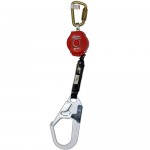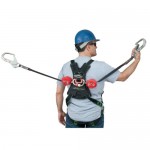Personal Fall Limiter: What Is It and How To Use It?
 In a recent blog post we talked about the limitations of the six-foot shock-absorbing lanyard. The chief weakness of this type of solution is that lanyards require a very high fall clearance.
In a recent blog post we talked about the limitations of the six-foot shock-absorbing lanyard. The chief weakness of this type of solution is that lanyards require a very high fall clearance.
A user wearing a 6-foot lanyard must travel the full length of it before it begins to arrest their descent, plus 3-1/2 feet of deceleration, for a minimum total fall distance of 9 1/2 feet (the total distance depends on the relationship between the anchor point and the user’s D Ring). Add 6 feet for the user’s height, plus 3 feet of space underneath the user per OSHA regulations, and you need a clearance of 18 feet from the anchor point (6 + 3-1/2 + 6 + 3 = 18 feet).
SRLs, on the other hand, require a clearance of only 6-1/2 feet. That is 3-1/2 feet for the length of the fall, plus another 3 feet of space underneath the worker per OSHA regulations. If a worker wearing an SRL takes a fall, the SRL will lock up and arrest their descent within 8 to 9 inches (maximum allowable pay-out is 24 inches however). It will then decelerate, often stopping the worker before they have traveled 3 feet.
If asked, most workers would tell you they prefer an SRL to a lanyard, since it is less stressful to fall 3 feet or less, than to fall 9-1/2 feet. Many companies, however, prefer to have their workers use a lanyard because it is a lightweight device that does not impede mobility. SRLs are heavy and cumbersome, and users can tire out after carrying one on their backs for a while.
But now, a new type of self-retracting lifeline is being introduced that has the potential to revolutionize fall protection systems, and to make the six-foot lanyard obsolete.
Personal Fall Limiters
The personal fall limiter (PFL) is a compact, lightweight SRL of limited working length of between 6 and 9 feet and weighs between 1-2 pounds. Unlike the regular SRL, which is mounted at the anchor point, the PFL attaches to the D-ring on a user’s body harness, and is light enough to be carried on the user’s back.
If a worker falls, the PFL works like a regular SRL, arresting their descent within 8 to 9 inches (with a total payout of up to 24 inches if needed). In short, the PFL offers the same mobility and ease of use as a lanyard, but can be used like an SRL in industrial areas with a short fall clearance.
A PFL can hook up to any type of anchorage, including single-point anchors and rebar walls. Most PFLs are rated to hold workers of up to 400 lbs., and most models include an integral swivel to prevent the lifeline cable from twisting. PFL models include Capital Safety’s Nano-Lok in single leg and twin leg models, and the Miller Scorpion, TurboLite and Twin Turbo models.
Twin-Configuration PFLs
 PFLs come in single and twin configurations. The twin configurations include two PFLs attached to the back of the user’s safety harness. They work like a Y-lanyard, allowing the worker to easily transfer from one anchor point to another. A worker can use their second PFL to attach themselves to a new anchor point before disconnecting their first PFL from the previous anchor point.
PFLs come in single and twin configurations. The twin configurations include two PFLs attached to the back of the user’s safety harness. They work like a Y-lanyard, allowing the worker to easily transfer from one anchor point to another. A worker can use their second PFL to attach themselves to a new anchor point before disconnecting their first PFL from the previous anchor point.

